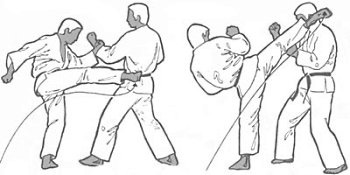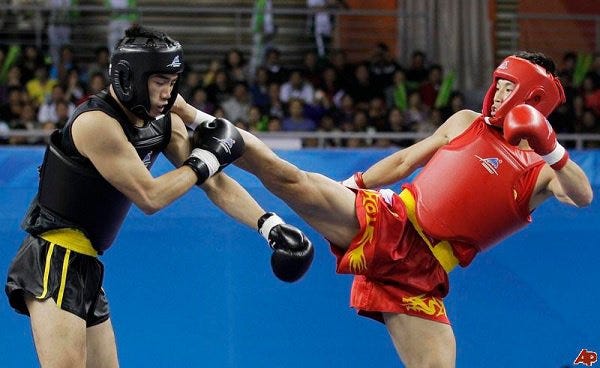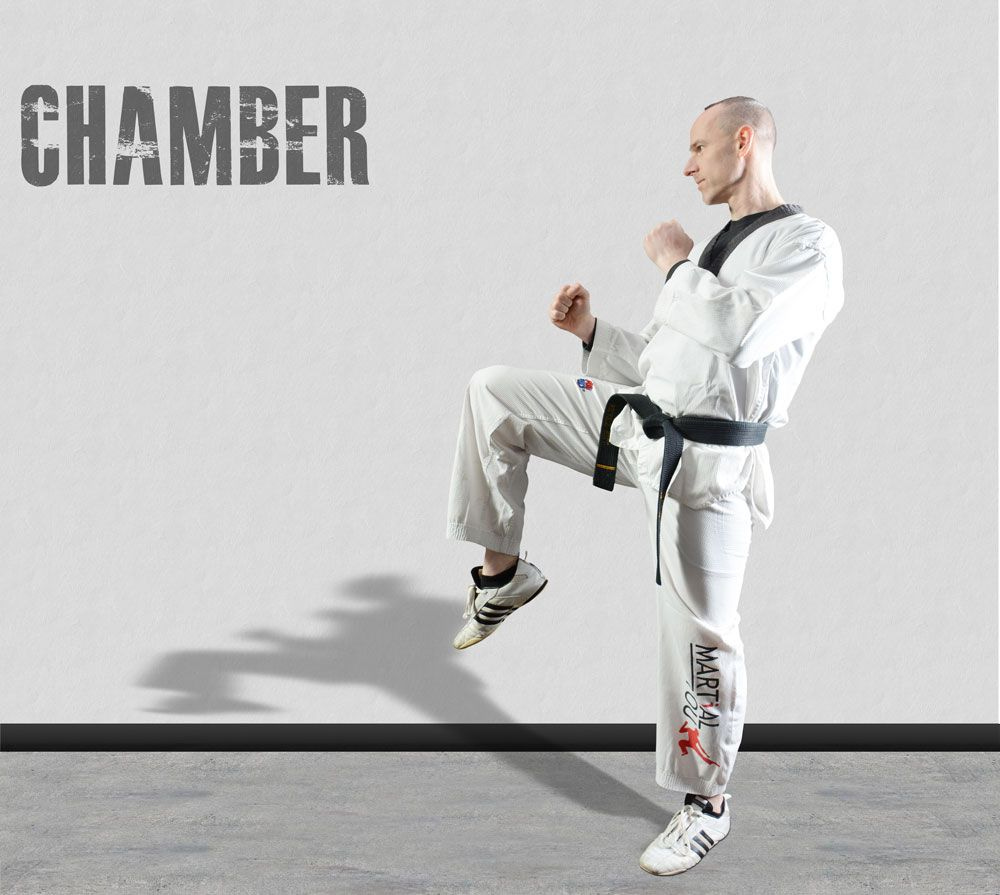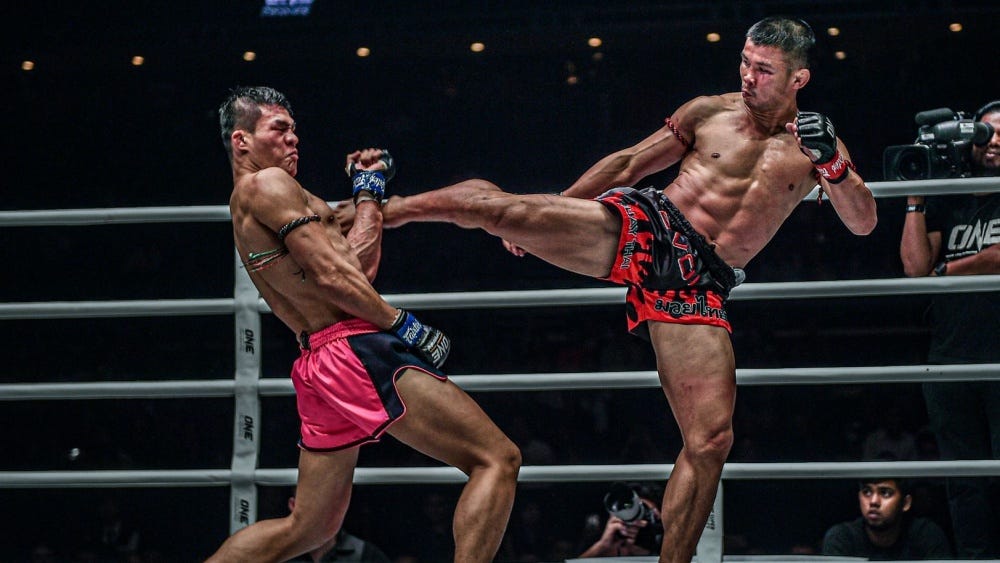Two Ways to Throw One Kick
The roundhouse kick is arguably the most iconic kick in martial arts. Many love the technique and use it extensively. It is quite universal as most striking-based martial arts have some variation of this kick as part of their technique roster. Hence, it would be worth discussing a key distinction between the different ways martial arts throw the kick.
For those who are uninitiated, the roundhouse kick is a circular kick that can be thrown to the head, body, or legs. There are two overarching ways to throw the kick. First, one can throw it in a snapping motion in which they raise the leg, turn it at an angle, and quickly snap the bottom half of their leg towards their opponent, making contact with the foot or shin, as seen in Karate, Taekwondo, and Sanda. Second, one can throw it as if it is a baseball bat in which they pivot outwards to open up their hips while throwing their whole weight behind the kick, as seen in Muay Thai. These two styles are distinctive not only in their performance but in their use. The former is a more versatile tool, more analogous to a jab, while the latter is a more powerful tool, more analogous to a cross. In this article, the objective is to elucidate the advantages and disadvantages of both.
A Quick Note
Given that martial arts styles are diverse, there are slight differences amongst martial arts styles in how they throw the kick. For example, Karate tends to throw the snapping roundhouse kick from the ground with a pivot, while Taekwondo tends to throw the snapping roundhouse kick from a front kick position. This article should not be viewed as denying these differences. Martial arts are diverse. Correspondingly, their techniques and specifics will also be diverse. This is true not only across martial arts but across schools within the same martial arts. Hence, nothing said here should be viewed as denying these differences. Instead, one should view this as trying to generalize to analyze.
…one should view this as trying to generalize to analyze.
As with many articles on this substack, it is important to generalize to be able to analyze the differences between methods. Yet, in doing so, this inherently means that one must temporarily ignore the diversity prevalent amongst styles; otherwise, the article would be too long, too difficult to follow, and hard to put to use. Therefore, to enable these articles to be useful, generalizations will be made. In doing so, this does not deny the diversity that exists within martial arts. It is merely abstracting trends and similarities for analysis.
Snapping Roundhouse Kick
The snapping roundhouse kick opts for speed and mixups over power. This style of roundhouse has numerous advantages. It is substantially faster than the baseball bat roundhouse kick due to the rapid snapping motion and the lesser amount of body mass thrown behind the kick. This allows it to function as a jab-like kick that can be utilized to probe the opponent’s defenses, while also dealing a smaller amount of damage over time.
Given its speed, this kick usually does not need a setup and it serves as a great combo opener, allowing one to throw it, quickly rechamber it, and move into other techniques. One simple version of this combo is a snapping roundhouse kick into a step forward with the kicking leg, then throwing a jab cross. Being able to set up combinations with a circular kick is beneficial, especially as many fighters do not see it coming. When I trained Muay Thai, ending a combination with a roundhouse kick was common, but beginning one with a roundhouse kick was rare due to the greater commitment the baseball bat roundhouse kick requires. In the same vein, the snapping roundhouse kick is great at creating openings as hitting the opponent on the side tends to pull the opponent’s arms away from their center, leaving openings for linear attacks.
Also, given the lesser commitment of this kick, it is easier to throw off the front leg, which can be a significant advantage, especially if the opponent is expecting a switch step. Similarly, the lesser commitment makes it easier to recover from a missed attack. Hence, there are fewer openings to punish someone who whiffs this kick.
Most interestingly, given that this kick tends to begin with a chambered position, it provides for easy mixups as one can throw alternative kicks from the same chambered position, such as a front snapping kick or heel kick to the leg. This allows for effective mixups in which the chambered position can be used as a means to psyche out the opponent as they do not know what may be thrown next. Moreover, if the opponent gets used to defending against the snapping roundhouse kick from a chambered position, one can readily throw a front snapping kick to the face or a heel kick to the leg to exploit the opponent’s pattern recognition.
While the mixup game the chambered position enables is quite strong and is often underutilized in several styles, it does have its weaknesses. Key amongst them is the risk of being swept or takedown while in the chambered position. As the chambered position requires one leg to be taken off the ground, most of one’s weight will be on the remaining planted leg, creating an opportunity for an opponent to quickly attack the remaining planted leg for an easy takedown. Hence, it is important when using this position to keep a few things in mind. First, be wary of range and power. One must throw their kicks at the proper range, keeping the opponent at a sufficient distance to avoid being countered by a well-timed sweep, takedown, or raw burst of forward aggression. One must also be conscious of throwing these kicks with substantial power as it punishes opponents who would get too aggressive with punishing the chambered position. If the opponent knew that in attempting to punish the chambered position they would catch a kick to the face or a stomp to the leg, they would be far more hesitant to attempt to do so. Second, do not remain in this position for long. Remaining in this position for any longer than necessary leaves one more open to being punished. Hence, as many mixed martial artists do, it is important to reduce the time spent in the chambered position as much as possible. Third, vary your attacks. Occasionally, one can punish those seeking to punish the chambered position by quickly switching to an unconventional attack, such as a switch kick or a flying knee. Never underestimate the power of catching one’s opponent off guard.
Baseball Bat Roundhouse Kick
The baseball bat roundhouse kick opts for power over all else. In contrast to its faster and more jab-like counterpart, the raw power of this kick leads it to be utilized for a different purpose. Instead of being jab-like, this kick is more analogous to a cross. It is more powerful, requires more commitment, and has greater stopping power. It is a powerful combo ender that can be used to sweep opponents. Given the power of this kick, it is easy to accidentally knock one’s opponent off balance. Also, this kick is dangerous to block. While checking the kick with the leg can lead to an injury for the kicker, blocking the kick by covering the body or head can seriously injure the blocking opponent. Moreover, reaching out to block the kick (usually, an intuitive but mistaken reaction), can lead to serious injuries for the blocking opponent.
While some may try to defend against this kick through forward aggression (as can be done with its snapping variant), it is far less effective due to the sheer power and the ability to turn the knee over to make contact with the front of the opponent. To effectively use forward aggression to shutdown the opponent’s baseball bat roundhouse kick, one must be constantly moving into punching or clinching range as it will provide insufficient space to throw the kick.
This version of the roundhouse is more effective at damaging the thigh due to the greater power. Snapping roundhouse kicks to the thigh can do damage, but they are nowhere near as powerful as the baseball bat variant. However, in the realm of kicks to the shin, it is still a matter of debate which is better. The tide of opinion seems to be leaning more toward the snapping version as it requires less commitment and telegraphing while being faster.
Contrary to the opinions of some, this roundhouse kick variant has mixups, just not as many as the snapping version. As mentioned prior, one can turn over their hip and knee to make the kick make contact with the front instead of the side of the opponent. Similarly, one can combo off of a blocked kick, even though it is less common.
Hence, while the snapping version opts for speed and trickery, the baseball bat version opts for raw power.
Foot vs. Shin
One thing not discussed in the prior sections is the area in which the two respective roundhouse kicks make contact. The choice to exclude the debate of whether to hit with the foot or shin was a conscious choice as, in my view, the debate is more conclusive than many other debates in martial arts. While hitting with the part of the foot that connects to the shin can be appropriate, hitting with the whole foot instead of the shin is inferior both for power and injury prevention. Hitting with the foot may grant some additional range, but the risks and loss of power are not worth it.
A story will help clarify why I believe this to be the case. When I was light sparring one day, my opponent threw a front snap kick toward my stomach. Instinctively, I raised my leg as if I was going to check a roundhouse kick, but instead centered it to block the front snap kick. Their toes made contact with my raised knee, leading to them breaking one of their toes. The risk of breaking many of the small bones in one’s foot while throwing a kick is not worth any benefit that is gained from doing so. It may be a different story if one is wearing boots or other equipment that protects the feet, but, for barefooted combat, kicking with the shin is superior.
It Depends on your Use Case
Which kick one prefers to use depends on how one would like to fight. When I fight in a more squared stance, I tend to use the baseball bat approach. When I fight in a more bladed stance, I tend to use the snapping approach. There is no one right answer for all times and places. It is up to the fighter to determine what they find works best for them.






